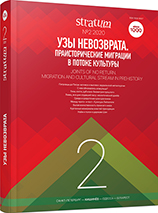Миграции из Передней Азии на Кавказ в позднем халколите (первая половина IV тыс. до н. э.)
Migrations from the Near East to the Caucasus in the Late Chalcolithic (first half of the 4th millennium BC)
Author(s): Najaf MuseibliSubject(s): History, Archaeology, Migration Studies
Published by: Издательский дом Stratum, Университет «Высшая антропологическая школа»
Keywords: Mesopotamia; Eastern Anatolia; Caucasus; Chalcolithic; Leilatepe culture; migration; burial rites; ceramics;
Summary/Abstract: The article deals with the issues of migration of the Late Chalcolithic tribes from Eastern Anatolia and Northern Mesopotamia to the Caucasus, as a result of which the Leilatepe culture was formed in the Southern Caucasus. The chronology of this culture is determined by the first half of the 4th millennium BC.The characteristic features of the Leilatepe culture is architecture of adobe brick, clay layers and above ground light construction, burial monuments — early kurgans, soil graves and child burials in ceramic vessels, high-quality rounded-bottom vessels with a funnel-shaped rim thrown in the potter’s wheel, stone products with a predominance of items made of flint, based on arsenious copper, etc. All these factors that substantiate migrations from Eastern Anatolia and Northern Mesopotamia were not known in the Caucasus before the emergence of Leilatepe culture. Production traditions, the main features of the burial traditions of the Leilatepe culture are associated with the monuments of Asian Near East. In its turn, the roots of the Maikop culture tradition recede into the area of Leilatepe culture.
Journal: Stratum plus. Археология и культурная антропология
- Issue Year: 2020
- Issue No: 2
- Page Range: 71-82
- Page Count: 12
- Language: Russian
- Content File-PDF

